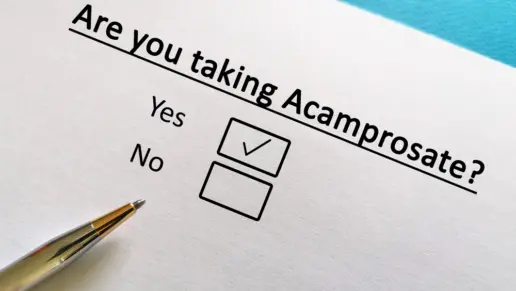Using Vivitrol (Naltrexone) to Help Treat Addiction
Medication-assisted treatment (MAT) has shown much promise in substance abuse treatment. When clients seek medication-assisted treatment for opioid addiction, they may be prescribed a medication called Vivitrol.
What is Vivitrol?
Vivitrol is a brand name for naltrexone, a medication approved by the Food and Drug Administration (FDA) to treat both alcohol and opioid addiction. Naltrexone is not an opioid, it is not addictive, and it does not cause withdrawal symptoms when stopped. Instead, it blocks the euphoric and sedative effects of opioids by binding to and blocking opioid receptors. This reduces and suppresses opioid cravings. There is no abuse potential with naltrexone. However, you must detox before starting naltrexone.
You must be opioid-free for at least 7 to 10 days.
Vivitrol should be used only as one component in a comprehensive medication-assisted treatment (MAT) program that includes counseling support and behavioral therapy.1,2
Vivitrol isn’t a new medication. It’s an extended release, injectable version of naltrexone, a generic drug that has been used since the mid-1980s to treat opioid addiction. Vivitrol is delivered by injection, into a muscle, and is usually administered once a month. It is recommended that Vivitrol be injected into the gluteal (butt) muscle. Naltrexone. It is appropriate for patients who have detoxed from opioids and those who are also being treated for a co-occurring alcohol use disorder.3,4,5
How is Vivitrol Prescribed?
MAT opioid treatment programs are required to successfully complete a certification and accreditation process through the Substance Abuse and Mental Health Services Association (SAMHSA) and meet other requirements. They must be licensed by the state in which they operate. Programs must also be registered with the Drug Enforcement Administration (DEA), through their local DEA office.6
Practitioners who may prescribe or dispense extended-release injectable Vivitrol/ naltrexone include any individual who is licensed to prescribe medicines (such as a physician, physician’s assistant, or a nurse practitioner). These practitioners may also order Vivitrol/ naltrexone to be administered to patients by a qualified staff member.7
Side Effects of Vivitrol/Naltrexone
Common side effects of Vivitrol/Naltrexone include:
- Nausea
- Dizziness
- Drowsiness
- Headache
- Vomiting
- Anxiety
- Tiredness
- Loss of appetite
- Joint pain
- Sleep problems (insomnia, waking too early)
- Mild withdrawal symptoms, such as abdominal cramps, restlessness, bone/joint pain, muscle aches, and runny nose, may also be experienced.1
Serious side effects from use of Vivitrol/Naltrexone may include:1
- Severe reactions at the site of injection
- Intense pain
- Swelling, lumps, scabs, blisters, or open wounds
- Liver damage or hepatitis is possible
- Allergic reactions, including skin rash, swelling of face, eyes, mouth, or tongue, trouble breathing, wheezing or chest pain may occur.
- Risk of opioid overdose. Accidental overdose can happen in two ways:
- Naltrexone blocks the effects of opioids. Patients who try to overcome this blocking effect by taking large amounts of opioids may experience serious injury, coma, or death.
- After receiving a dose of naltrexone, the blocking effect slowly decreases and completely goes away over time. Patients who are taking naltrexone for opioid addiction can become more sensitive to the effects of opioids at the dosage they used before, or even at lower amounts. Using opioids while on naltrexone can lead to overdose or death.
Using Vivitrol to Treat Alcohol Addiction
When used to treat alcohol addiction, Vivitrol can help by:
Limiting alcohol cravings.
Treating the physical dependency.
Helping change habits over time.
When starting naltrexone for alcohol use disorder, patients must not be physically dependent on alcohol or other substances. To avoid strong side effects, practitioners typically wait until after the alcohol detox process has been completed before administering naltrexone.1
Naltrexone binds to the endorphin receptors in the body and blocks the pleasurable feelings and effects of alcohol. It also reduces alcohol cravings, therefore reducing the amount of alcohol that is likely to be consumed. Once a person stops drinking, taking naltrexone helps to maintain the sobriety. Naltrexone treatment typically lasts for three to four months. But practitioners often continue to monitor patients who are no longer taking naltrexone.1,6
Using Vivitrol to Treat Opioid Addiction
When used to treat opioid addiction, Vivitrol reduces cravings for opioids and therefore reduces the likelihood of relapse. To reduce the risk of withdrawal symptoms, patients need to wait at least 7 days after their last use of short-acting opioids and 10 to 14 days after taking long-acting opioids, before starting naltrexone. They should not use any other opioids or illicit drugs. They should not drink alcohol or take sedatives or tranquilizers.1,6
Patients on naltrexone, who discontinue it, or who relapse after a period of abstinence, may have acquired a reduced tolerance to opioids. Therefore, taking the same, or even lower doses of opioids as they used in the past, can cause life-threatening consequences.1,7
Things to Remember Before Starting Vivitrol/Naltrexone
If you are thinking of starting Vivitrol, before beginning treatment you should talk to your doctor to discuss the following:
- Current liver problems, hemophilia or other bleeding problems, kidney problems, or other medical conditions you may have.
- Whether you are pregnant, you plan to become pregnant, or you are breastfeeding.
- Your current medications, prescriptions, and non-prescription medicines, including vitamins and herbal supplements.
- Whether you are currently taking any opioid-containing medicines for pain, cough, colds, or diarrhea.
- Whether you are currently being treated for an opioid use disorder or alcohol use disorder.
- If you are allergic to naltrexone or any of its ingredients, or to the liquid used to mix extended- release naltrexone.1,7
You should not take Naltrexone at all, or stop using it if you
- Currently use or have a physical dependence on opioid-containing medicines or opioid drugs, such as heroin, or if you are currently experiencing opioid withdrawal symptoms.
- You experience opioid withdrawal symptoms while on Vivitrol/naltrexone. Opioid withdrawal symptoms may include anxiety, sleeplessness, yawning, fever, sweating, teary eyes, runny nose, goose bumps, shakiness, hot or cold flushes, muscle aches, muscle twitches, restlessness, nausea and vomiting, diarrhea, or stomach cramps.1,7
If you work closely with your doctor and are compliant with MAT program policies, you can safely use Vivitrol/naltrexone to recover from opioid abuse.
Addiction Centers Nearby that offer Medically Assisted Detox
Finding facilities near you…
Resources
- Chanell Baylor. (2022, July 25). Medication-Assisted treatment (MAT) | SAMHSA – Substance Abuse and Mental Health Services Administration. Samhsa.gov. https://www.samhsa.gov/medication-assisted-treatment
- National Library of Medicine. Stat Pearls (internet). Naltrexone https://www.ncbi.nlm.nih.gov/books/NBK534811/
- What is Vivitrol? | UAMS Psychiatric Research Institute. (n.d.). Https://Psychiatry.uams.edu/ https://psychiatry.uams.edu/research/center-for-addiction-research/what-is-vivitrol/
- Medical News Today. Vivitrol dosage https://www.medicalnewstoday.com/articles/drugs-vivitrol-dosage.com/
- SAMHSA.gov. SAMSHA Advisory: An Introduction to Extended-Release Injectable Naltrexone for the Treatment of People With Opioid Dependence https://store.samhsa.gov/product/An-Introduction-to-Extended-Release-Injectable-Naltrexone-for-the-Treatment-of-People-with-Opioid-Dependence/SMA12-4682
- SAMHSA.gov. Certification of Opioid Treatment Programs (OTPs) https://www.samhsa.gov/medications-substance-use-disorders/become-accredited-opioid-treatment-program
- Substance Abuse and Mental Health Services Administration. Clinical Use of Extended-Release Injectable Naltrexone in the Treatment of Opioid Use Disorder: A Brief Guide. HHS Publication No. (SMA) 14-4892R. Rockville, MD: Substance Abuse and Mental Health Services Administration, 2015. https://store.samhsa.gov/product/Clinical-Use-of-Extended-Release-Injectable-Naltrexone-in-the-Treatment-of-Opioid-Use-Disorder-A-Brief-Guide/SMA14-4892R
- Leavitt, S. (n.d.). Evidence for the Efficacy of Naltrexone in the Treatment of Alcohol Dependence (Alcoholism).





